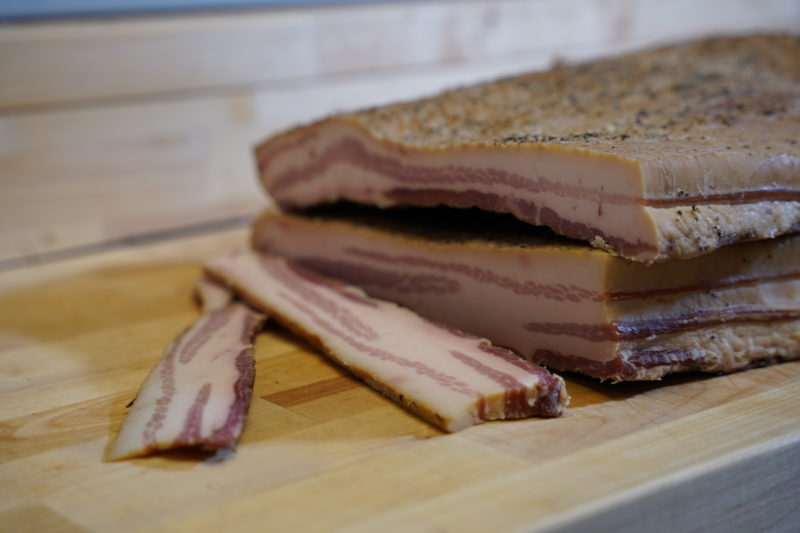Bacon is everywhere. We eat huge amounts of it. We love it. We joke about it. We add it into every other food dish we possibly can, for no other reason than “because we can.” Sure, we cherish it, but do we really understand what makes good bacon so great?
Curing meat, especially old-school bacon, is in a class all by itself, but what’s the secret behind its flavor, cooking properties and overall amazingness? It’s all in the history, of course…a process that has been perfected over (literally) thousands of years!
Preserving meat so that it can be eaten later goes back to before recorded history. Civilizations were salting fish and meat to prevent spoilage and to keep for when food became scarce. In fact, the ancient Mesopotamians, Egyptians, Greeks and Romans all practiced curing (and found different ways to make it their own)!
Did you know that there’s even evidence that suggests desert-dwelling populations in both western China and South America used sand high in borax and sodium nitrate as a preservative?
Preservation of meat also goes back to prehistoric times. It likely started as a method for cooking, but humans eventually realized that meat dried over a smoky fire stayed edible longer. In the centuries that followed, some meats were cured with salt first, then smoked to add additional flavor. (Welcome, Black Sheep Bacon!)
The Roman Empire
The Ancient Romans borrowed much of the salt curing process from the Greeks, but soon adapted it to their tastes. Dry cured ham, particularly from the shoulder, was especially prized.
After a few months’ worth of cure, the ham would be boiled, then covered in honey and baked. Sausages were also extremely popular, especially among the lower class. And, the Roman Emperor Aurelian was so worried about the mass consumption of pork that he enacted laws to keep pigs from going extinct!
The Middle Ages
The popularity of cured meats continued into the Middle Ages. This is when brining and pickling (which preserves meat in salted water) started to become more common in food preservation. Spices from the East made their way onto the scene, and helped to cover up the extremely salty taste of the preserved meat.
This is around the time in history when we started seeing references to cured pork bellies in historical record and literature. Meats were sometimes smoked as well, but smoking added to the final cost of the meat. (So, basically, if you were wealthy, you got to eat the good, smoked stuff!)
The Modern Era, the 20th Century & Beyond
By the mid-nineteenth century, railroads made it easier to get pigs and cattle to stockyards for slaughter, and by the turn of the twentieth century refrigeration basically changed the world! The meat industry became a year-round venture, rather than one controlled by the outside temperature, and beyond bacon, charcuterie boards across the world benefited from easier access to salami, sopressata and more!
Dry curing became less common, and traditional meat preservation methods that included curing salts, which preserved meat’s distinct pink and red color, began to die out…this is when the commercialized, pre-packaged stuff officially made its way into our grocery stores.
European Curing Traditions
European meat curing processes varied from country to country and region to region.
In Germany and central Europe, meats were cured and smoked using beechwood or juniper. Closer to the Mediterranean, in Italy, Spain, and Portugal, meat was often just salt cured (and not smoked). Well-known Italian cured meats like prosciutto or pancetta, for example, receive no smoking.
When those Europeans eventually made their way to the Americas, their methods mixed with the existing practices of the native populations, which included the smoking of meats using common North American woods. (The most common types used were hickory, oak, and mesquite, but applewood, cherrywood, and even corn cobs were also used.)
What Makes Bacon, Bacon? It Depends Where You Live!
What exactly constitutes “bacon” is slightly different depending on the country you live in.
In North America, “bacon” describes the meat from the belly or side of the hog, and “Canadian bacon” comes from the back.
In the United Kingdom, however, American bacon is known as “streaky bacon” because of the streaks of fat that run throughout. It is not typically eaten on its own, but instead used to wrap chicken or sausages. British bacon comes from the loin of the hog, with a border of fat along one edge, and is most often NOT smoked.
No matter where you’re from, though, bacon still manages to find its place at both the breakfast table and on a good lunch or dinner time sandwich.
Keep Going – Become a Cured Meat (Bacon) Expert!
We’ve covered a lot of history, but we’re not done. To dive deeper into the world of cured meat products, especially bacon, take a look at our complete, in-depth overview: Ultimate Guide to Dry Cured Bacon!

